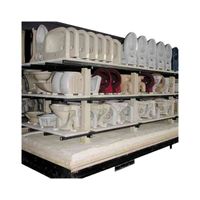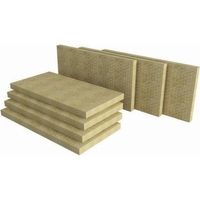Roof blanket (10 cm) (18 kg/m3)
- $10.00 / >=40 cubic meters
- 40 cubic meters
- BALCIOGLU GRUP STANDART IZOLASYON VE YAPI MATERYALLERI SANAYI TICARET ANONIM SIRKETI
- Istanbul, Turkey
- Ms Mevlude Parlak
| application: | Adiabatic | Supply capacity: | 500 cubic meters per week |
| work: | rock wool | Package preview: | |
| Packaging details: | wooden pallet or customized | port: | turkey |
| model: | Insulating rock wool | Place of origin: | istanbul, Türkiye |
| aspect: | Thickness 15mm-200mm | Application places: | insulation |
| brand: | Insulating fleece | payment terms: | Letter of credit, wire transfer, MoneyGram |
| Product Category: | roll |
Roof blanket is a lightweight, non-combustible, faceless glass wool product.
Application areas:
- Various tendencies for metal and wood roofs,
- unused attic,
- Warm pitched roof,
- steel structure industrial buildings,
-Double cladding roof,
- At animal shelters and chicken farms
Thermal properties
Although gases are very poor conductors of heat, they are very good thermal insulators. Due to its porosity, mineral glass wool can trap air within its pores, achieving almost the same thermal conductivity as a gas. Due to the sufficient pore size, heat transfer through convection, radiation and conduction is avoided to the greatest extent.
In order to define thermal performance, specifications must refer to a number of parameters:
Thermal Conductivity(expressed in W/mK)
d thickness(usually in meters)
These two characteristics defineThermal resistance Rin meters2kilowatt/watt
Logically, density does not appear in the definition. For the same product with the same density, different thermal conductivities may be obtained due to differences in raw materials, production processes or porosity. Density simply represents the amount of natural resources a product consumes to achieve its insulating function. Increasing density without improving thermal performance (conductivity) will only have a negative impact on the environment.
acoustic performance
Mineral glass wool is a suitable product for sound insulation systems. Due to its ordinate filamentous nature and elastic structure (thanks to the raw materials and its production process),Sound waves that penetrate its cushioning are absorbed, allowing much less sound to be transmitted to the other side or reverberate within the same space.This way, airborne noise, impact and reverberation propagates much less.
Products for use on facades, inside partition walls, on floors and ceilings are ideal for soundproofing and help increase the degree of privacy between different rooms and/or houses.
Acoustic propertiesIn order to understand whether a material is a good sound insulator, the acoustic properties to consider are:Stiffness and airflow resistance.Mineral glass wool manages to have very low stiffness values due to its high elasticity. Rigid products destroy effectiveness. The intrinsic property of the product evaluated for this property is dynamic stiffness (s'=Epower/d) expressed in MN/m3
Another acoustic property to consider is airflow resistance. The optimal value must be between 5-10 kPa.seconds/meter2. Below 5kPa.seconds/meter2The insulation material does not provide sufficient sound absorption and exceeds 10 kPa.seconds/meter2Because the material is very dense, noise propagates primarily through solids.
fire response
Due to the stony origin of the raw materials (mainly sand and other minerals), glass wool has fire-resistant properties and is classified as Class A1. When we add finishes to glass wool, the fire response will change. Response to fire indicates contribution to fire initiation and development and must be specified by:
The European grade's degree of reaction to fire complies with TS EN 13501-1.
The performance of a complete building element (partitions, walls...) is evaluated by the fire resistance stability of its constituent materials, which need not be confused with fire reaction. For panel partition systems filled with mineral glass wool, fire stability values may easily reach 120 minutes.
High temperature behavior (for moisture)
Mineral glass wool is water-resistant (non-hydrophilic) and non-capillary. This means it neither absorbs nor transmits moisture through its pores. In order to avoid condensation inside the partition, the temperature must be as high as possible and the partition must be evaporable.
Easy installation
Due to its elasticity, mineral glass wool adapts well to the irregularities of building elements and allows the installation of correct insulation continuity over its entire surface without visible seams and forced cuts (which can lead to possible thermal bridges or sound bridge)). In addition, roll insulation can reduce waste caused by installation levels.
environment
How does mineral glass wool play an energy-saving role?
Assess all environmental impacts of minerals producing glass wool, from"From cradle to grave"(Extraction of raw materials, production, life cycle of the building, and subsequent demolition and end of life of the glass wool). The amount of energy we save is greater than the amount of energy we consume. During the production process, mineral glass woolIt is the thermal insulation material with the lowest impact on the environment because it has the highest contribution to protecting the environment.Thanks:
-Natural and inorganic propertiesMineral wool (mineral glass wool).
- Raw materials composed of natural minerals (sand, calcite, magnesium oxide...) which are extremely abundant on Earth and can be considered virtually inexhaustible.
- Reduced consumption of natural resources due to the outstanding benefits of extremely light products.
- The recycling of outer glass is combined with environmental protection to increase the value of used glass.
- Minimize plant wastewater through filtration and selective collection.
- Maximum thermal and acoustic performance with minimum consumption of natural resources (low density).
Technical characteristics (according to TS EN 13162 standard)
| Thermal conductivity (10℃) (λ value) | 0.035 W/m·K |
| Fire level | A1 |
| Thickness tolerance | T1 |
| Dimensional stability | DS(T+) |
| Thermal resistance RDrice2kilowatt/watt | 2.85 W/Mikel |






